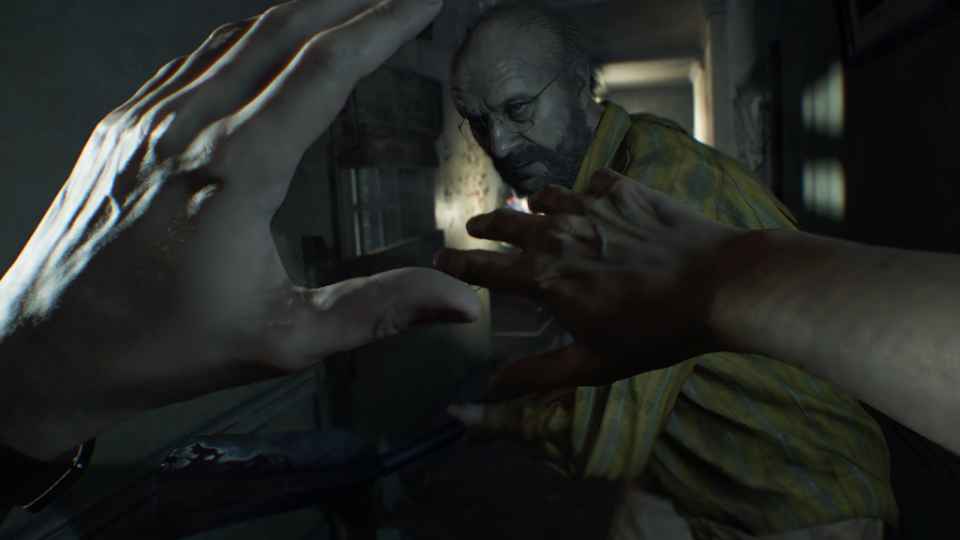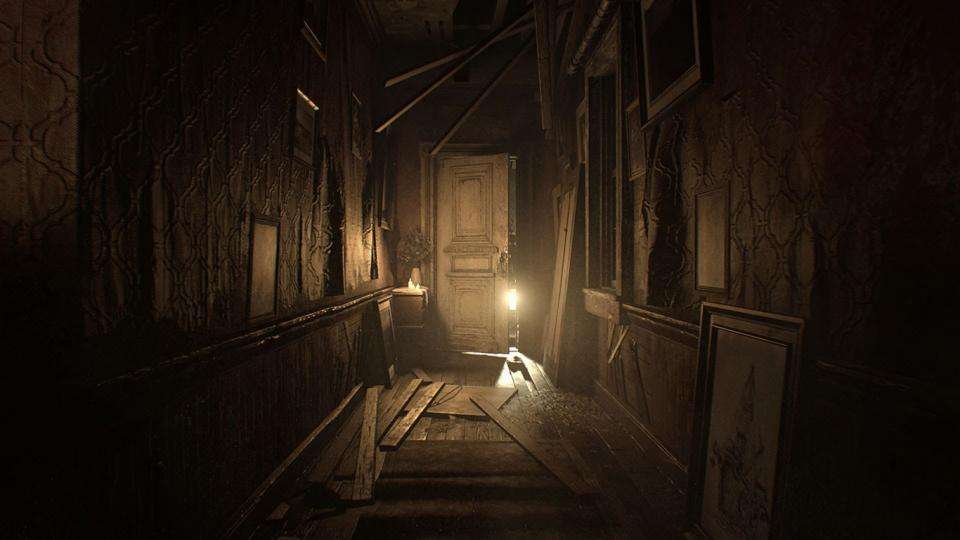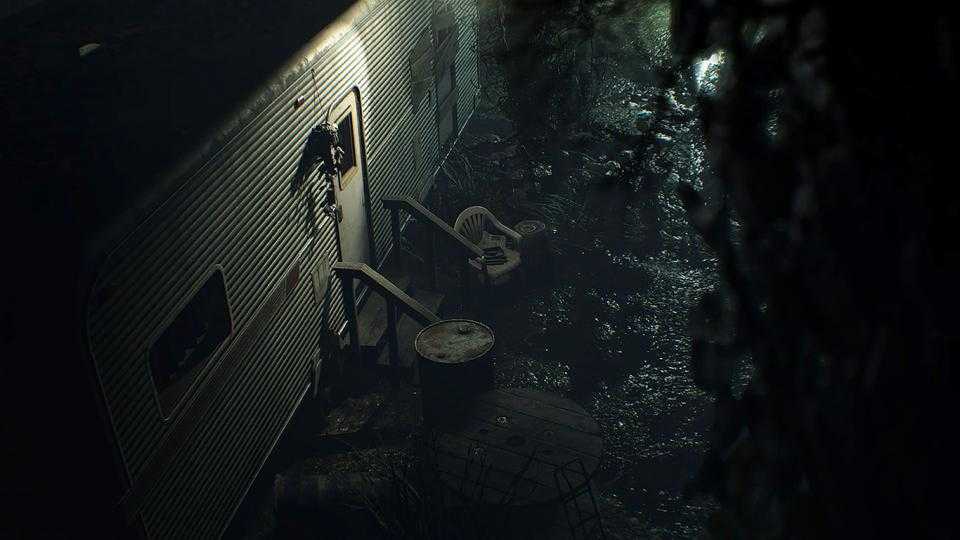The sound of the crackling is warm. That’s the word I would use to describe it. It is warm and, more importantly, it is music. If you’d asked me a week ago how it would feel to hear the faint, warm crackling of a record player, I wouldn’t have given you an answer this effusive. I wouldn’t have grabbed you by the collar, brought your face within inches of mine, and told you that it makes me feel safe.
But the save points in Resident Evil 7: Biohazard make me feel exactly that. The tape recorder that lets me save my progress, the crackling music. Like a bonfire, I feel my body defrost. This is so different from the silence outside of these rooms. A silence that, like John Cage’s famous 4’33” composition, isn’t a silence at all, but rather a blank canvas for the rustles, crunches and whispers of other humans. Except, in Resident Evil 7 ’s case, these sounds aren’t necessarily all human.
Sound is such an important part of horror, and the newest entry into Capcom’s long-running survival series is a game full of sounds. From the creak of distant doors opening, to the swish of a body moving past tarpaulin, the Baker’s plantation is an isle full of (foreboding) noises
Many of these come from the Bakers themselves – the family unit at the heart of Resident Evil 7 . Cast in the role of Ethan Winters, searching for a wife that has been missing for three years, it isn’t long before you’re sat face to face with this gallery of grotesques. Prime amongst these is mother Marguerite, son Lucas, and father Jack.
Unlike the previous couple of core Resident Evil entries, which attempted to straddle knots of woven storylines and series-staple characters, No.7 pares things down considerably – focusing for a large portion of its narrative on Ethan and the Baker clan. They are outlandish, melodramatic and increasingly daft, but this familial grounding greatly benefits the game’s focus. It’s hardly Eugene O’Neill , but the violence in this American family anchors the disgust – gives it roots.

Resident Evil 7 review: Violence in the family
After an extended prologue, many of the first hours in the game are spent contending with Jack. These are the moments where Resident Evil 7 is at its best, when the huge plantation remains an unknown labyrinth of dark places. It is also, not coincidentally, when the horror of the game is at its most human. Jack is a threatening figure, and not because he has some nasty mojo in his system. He’s scary because he is a violent father. He walks and talks with the assuredness of someone who has committed great abuses before. He looks for you as if he knows exactly where to find you.
I’m reminded of a clip of Studio Ghibli founder Hayao Miyazaki, being given a presentation of a game AI learning to move a zombie body . Miyazaki calmly tells a story about a disabled friend, and the pain it causes this friend to even give a high five. That is pain, suggests Miyazaki, but whoever created the flailing AI zombie has no idea of what real pain is. He calls it an insult to life itself.
Resident Evil 7 is certainly more on the game AI side than the Studio Ghibli side, but those first hours with Jack are terrifying because they have a glimmer of humanity to them. When you eventually venture into the basement, and see the horrors within, it doesn’t feel like an arbitrary gauntlet. It feels – like the subterranean room of the Bates Motel – part of Jack’s interior mind.
"Those first hours with Jack are terrifying because they have a glimmer of humanity to them"

That psychological depth fades. Things get weirder, the human anchor loosens, and, perhaps inevitably, familiarity with environments robs them of their tension. The game does a good job of habitually undermining any sense of comfort you may have, but as I progressed I could feel myself shifting gear, from tense exploration into survival game mode. I cared less about staring into every nook and cranny, or looking at every photo and scrap of paper, and more about getting through objectives. There are good ludonarrative reasons for this – if you’re in a rush to do something you’re hardly going to stop and sniff the environmental storytelling – but I did miss the pace of the beginning, and the richness of those early environments. Perhaps most damagingly, however, is that this made me care less about those that wanted to do me harm.
Resident Evil 7 review: Virtual bodies
A later stage, which actually takes the form of a monitored escape-room game, brings this environmental focus back with purpose. It’s an interesting jolt to the game’s by-then swift pace, but with its elaborateness it also felt like the game’s most contrived moment – as fun as it was.
This was one area angled towards the optional use of PlayStation VR. Like scenes in 3D movies where some sharp object will reach out to camera, there are moments in Resident Evil 7 that seem particularly intended for virtual-reality consumption. A bug-filled corridor here, a room puzzle there. For the most part, these are far from clunky, but it is interesting to see that VR game tropes are already becoming so recognisable.

Not that you need to limit VR usage to those sections. The entirety of Resident Evil 7 can be played within a headset, and switching back and forth between the two modes is as simple as flicking a switch in the options menu. This makes Resident Evil 7 the fullest game yet in virtual reality, although Capcom recommends you don’t blast through the whole thing this way. While I’m lucky enough not to feel motion sickness in VR, a friend did feel nauseous while playing – particularly in sections where there is a lot of movement. The slower-paced, room-scale sections of the game, on the other hand, are easier for the brain to digest.
So, does VR mode make a big difference? Yes, particularly within those opening hours and their emphasis on tense, environmental exploration. Being able to lean forward and physically peer at objects, or peek around corners, gives the game an unsettling sense of reality. The first sections of real action are also terrifyingly present, although turning at 30-degree intervals – something intended to reduce a sense of nausea – does feel awkward. This might be most harmful to another game, but Resident Evil is all about unwieldy gun control, so it arguably adds another layer of panic to combat. That said, boss fights can become confusing in VR, particularly one mid-game that sees you scooting across several floors of interior and exterior areas.
The sense of presence also comes with a graphical sacrifice. The game is less visibly impressive in VR, and at times looks like something from the PS3 era. All of that is made up for with the brilliant use of audio, however. Hearing a creak behind you is made all the more terrifying when you have the sense that there is, in fact, a world behind your head. It doesn’t play like a game solely built for VR, but nor does it feel like a game with VR tacked on, and that’s a happy medium for a technology not yet in everyone’s living rooms.
Resident Evil 7 review: Returning to roots
The first-person perspective of Resident Evil 7 borrows much from the school of Amnesia: The Dark Descent and Alien: Isolation (with fewer, but supposedly smarter enemies than Resident Evil 4-6 ) but also returns the favour for games such as Fullbright’s Gone Home , which took and subverted the original Resident Evil formula.
For all the changes afforded by the shift in perspective, however, Resident Evil 7 feels very much like the first Resident Evil . The main portion of the action takes place across a mansion riddled with puzzles, and the roots of panic often stem from risk/reward choices between a scarcity of resources and inventory slots. I felt perpetually underpowered and slow to move as I backtracked through areas, and only got through each encounter by the skin of my teeth. There are also clever nods to previous titles – my favourite being the subtle echoes of Resident Evil’s loading screens in the plantation’s many stairs and doorways .

Most importantly, there are those save points. Things have become more forgiving since the original Resident Evil (you no longer need ink ribbons to save), but these scattered islands are crucial to what makes survival horror so effective. The warm crackle of a record throws all the darkness into relief. I felt safe in those rooms, and I knew that as soon as I crossed the threshold the music would fade out of earshot. I knew that I would soon be left with the creaks and groans of bodies moving to find me.
When those bodies have some human root, Resident Evil 7 can be a disturbing experience. When those bodies lose their sense of reality, the game quickly becomes a veiled machine of systems designed to scare. Regardless, it’s a well-made machine, and the game remains a well-crafted journey throughout – one that makes great use of its first-person perspective and one that brings a renewed sense of urgency to gaming’s most famous horror series.

